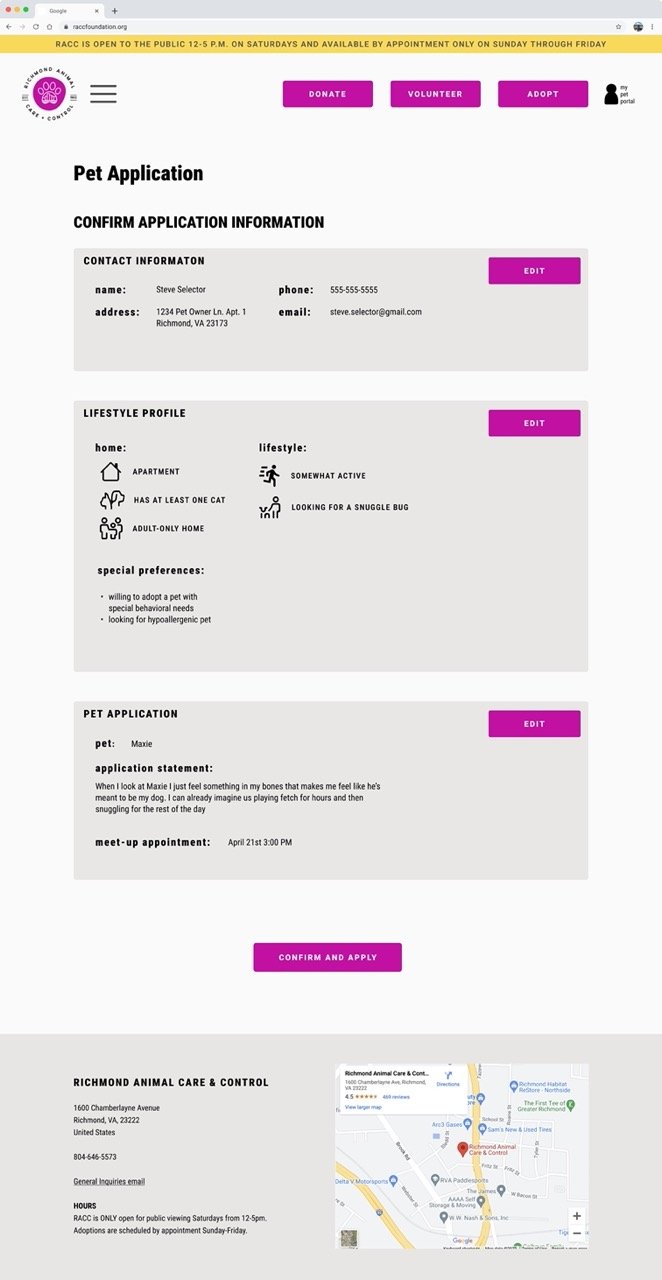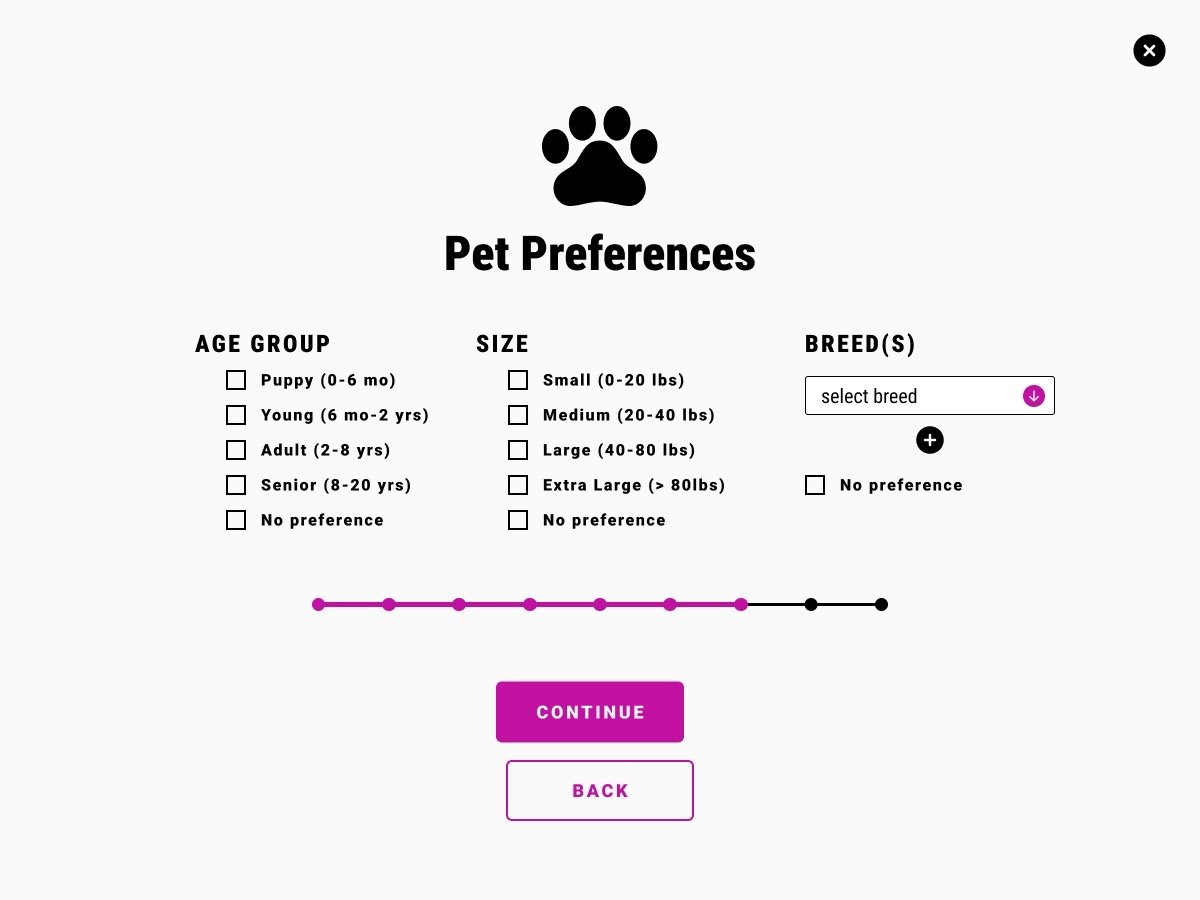Richmond Animal Care + Control Saves Lives
Matching rescue animals with their potential adopters
-
Team
Laura Kluball: Lead UX Researcher
Tina Radford: Lead UI Designer
Victoria Weiss: Branding & Art Director
-
Duration
A 2-week design sprint
Student Concept Project
-
Tools
Figma
Google Suite
Microsoft Excel Spreadsheets
Microsoft Visio
Mural
Otter AI
Pen and Paper
PowerPoint
Zoom
Image adapted by Victoria Weiss
About The Client: Richmond Animal Care + Control
Richmond Animal Care + Control is a well-known non-profit animal shelter in Richmond, Virginia. Their services are unique, because they are Richmond, Virginia’s ONLY open-admission public animal shelter, meaning they don’t turn any animals away, including those with health and behavior impairments. Their belief is that “every life is worth trying to save,” a viewpoint that is apparent in their actions. Every year, RACC rehabilitates and re-homes over 3,000 animals. [1]
The Challenge
RACC wants to implement a single responsive site that meets the needs of their target users.
Prospective adopters and volunteers are confused, because there are multiple places online for them to get information. Richmond Animal Care and Control (RACC) has their own website, but they are also supported by the RACC foundation, and adoptapet.com, where the actual list of available pets resides. RACC receives a lot of phone calls every day for clarification about the availability of specific animals. RACC knows that they need a better way to support their volunteers, donators, and future pet parents.
Research Methods
-
Primary
User Survey
Usability Testing
User Task Analysis
User Interviews
-
Secondary
Business Analysis
Heuristic Evaluation
Competitive Task Analysis
Comparative Feature Inventory
Narrowing Down Where Users Are Getting Stuck
To narrow down where users are getting stuck, each design team member reviewed the donation, volunteering, and adoption processes on the RACC website. We navigated through each process with the intent of completing the action of donation, volunteering, and animal adoption. We took notes about likes and pain points for each pathway.
Insight #1
We found pain points in the adoption process, not in donations and volunteering. After analyzing our research data, our team discussed the findings and agreed that there were no major pain points associated with the donation and volunteering pathways. Both processes are straightforward and easy to navigate. However, we did we run into a few snags with the adoption process.
Insight #2
The biggest pain point we noticed while going through the adoption process navigation flow was being redirected multiple times after clicking adopt, rather than being brought straight to a list of available dogs. The first step we were took was to click on the black “adopt” link at the top of the screen. This action brought us to the next page.
Insight #3
When we arrived to the “Adopt from RACC page, we had to scroll through text to “see available RACC pets” button. This caused some discomfort, because we had to scroll through a chunk of text to find the “Available RACC pets” button. Once we found the button, we clicked on it, expecting to be brought to a list of available pets on the RACC site, but we were re-directed to another website, adoptapet.org, which caused a disconnect.
Insight #4
After clicking the “see available RACC pets” button, we were re-directed to adoptapet.org, causing a disconnect. We initially thought the re-direction was a mistake and went back to the previous page to try again. Some other frustrations we encountered while testing the adoption process were about the search and filter features.
What Do Pet People Want?
Now that we had narrowed our focus pathway as the adoption process, we were ready to move onto figuring out who are target users are and how they go about adopting pets. To do this, we conducted a survey of 16 current, or soon-to-be, pet parents. With our survey, we hoped to learn:
Where do people look for pets?
How do users communicate with the individuals or organizations they get their pets from?
What do users prioritize when looking for pets?
What are the pain points people are currently experiencing when finding and obtaining a new pet?
How Do Pet Parents Find Their Furever Babies?
60%
of participants found their pet(s) online
Most Prospective Pet Parents Want to Adopt!
88%
of participants said they would be interested in adopting their next pet
What’s Stopping Pet Parents from Adopting?
-
Unclear Communication
“Clear communication about behavioral issues didn't happen and caused (literal) pain.”
— Survey Participant
-
No Adoption Process Updates
“...waiting for reply emails/not knowing what stage of the process we were at when getting the dog (not knowing if the dog was taken by another family, not knowing the exact date of arrival).”
— Survey Participant
-
Difficulty Finding the Right "Fit"
“I have specific breed allergies.”
— Survey Participant
Two Personas Emerged From Our Survey Data


The Problem:
Prospective adopters need an efficient way to narrow their pet search, along with a consistent way to communicate with the rescue so that they can easily and enjoyably adopt dogs that meet their needs.
As a team we conducted a design studio to ideate solutions for the problem.
Image created by Victoria Weiss
Steve and Cathy’s User Journeys
A Few Meowner Changes and Pet Parents will be Howling Praises!
Based on our sketches from our design studio, we created grayscale digital wireframes in Figma, focusing on the needs, wants, and frustrations of Cathy and Steve.
To address the user pain points of unclear and inconsistent communication with the adoption agency, we developed a curated pet portal, in which users set up communication preferences for each part of the adoption process.
To address user concerns about finding a pet that is the right fit for them, we created a pet-matching questionnaire that matches users with a list of suggested pets, based on their preferences. If no pets match users current needs, they can sign up to be alerted at a later time if one becomes available. We also added additional filters, to help users narrow down their search.
TLDR key changes include:
Personalized pet portal and profile
Application status updates
Set up personal pet preferences
Matching quiz
% Match visible on dog viewing page
-
Application Status Updates
To address the user pain points of unclear and inconsistent communication with the adoption agency, we developed a curated pet portal, in which users set up communication preferences for each part of the adoption process.

-
Pet Preferences for Curated List
We added additional check-box filters on the available dogs page, to help users narrow down their search.

-
Match % Visible on Dog Page
Based on the matching assessment, users will see a clear % match label at the top of every dog viewing page.

Usability Testing
To ensure that our users were satisfied with the changes we made, we conducted usability testing with our grayscale wireframes. We asked our 6 participants to complete the following tasks:
Complete the matching assessment and apply to adopt a dog you matched with.
Use the portal to address an issue with your pet application.
Users Wanted More Freedom and Positive Feedback!
-
Signing In
“I want to take the quiz without having to sign into the pet portal.”
— Test Participant
-
Immediate Results
“I would like to know my results as soon as I finish my quiz and submit an application.”
-Test Participant
-
Excitement!
“It would be nice to have some more excitement when I schedule an appointment to see a dog; it felt more like making a dentist appointment.”
-Test Participant
Summary of Changes Made After Usability Testing
Based on user feedback, we developed a high-fidelity prototype that contained these changes:
Changed quiz, so you can choose to log in, create pet portal account, or take the quiz without logging in (all buttons, last button is different color)
Increased font size because of readability issue in user test
Made breed selection drop-down instead of text field (providing users with suggestions)
Separated out special preferences from the other filters because users felt like these items were more important and needed their own category.
Added an almost done screen with options
Create pet portal account or continue without creating an account (two buttons with differently colored buttons)
Created “guest” checkout alternative where preferences will show up as checked
After finishing quiz, adding the option to create an account after taking the quiz, or continue to view results






Reflection and Next Steps
Throughout this design project, my team and I were able to conduct our first design studio and learn the value of quick sketching and iteration to solving user problems. Throughout the design challenge, we worked hard to understand our user’s specific pain points and challenges, in order to curate a personalized profile, that would make the adoption process more enjoyable and efficient.
As the Lead UX Researcher, if we had more time on this challenge, I would like to go deeper with user research and usability testing. In order to validate our research findings, we need to interview and test more users, with a variety of backgrounds. Additionally, I would like to increase the accessibility of the site by allowing users to select a language preference in their portal. For instance, 5.38% of Richmond residents are native Spanish speakers and I discovered while researching RACC’s social media pages, that there were requests from community members to have a Spanish version of the site. This could potentially increase the number of pet adoptions and lives saved!











